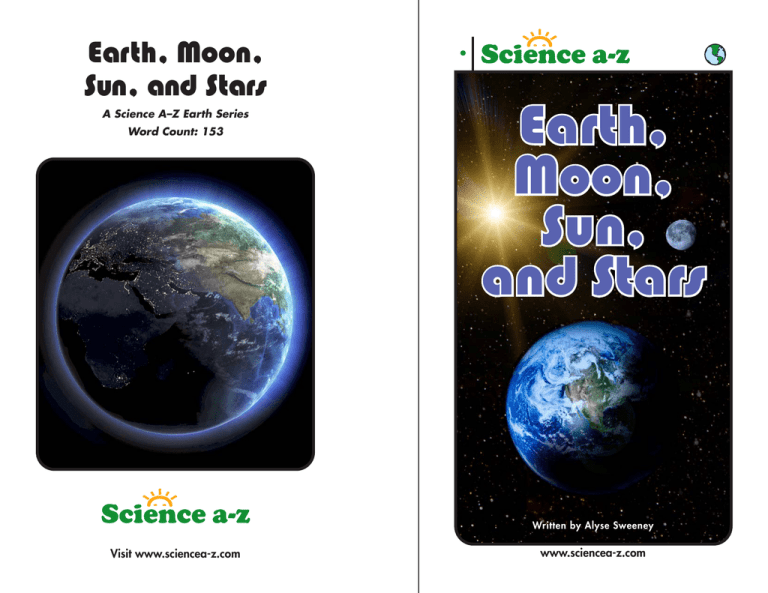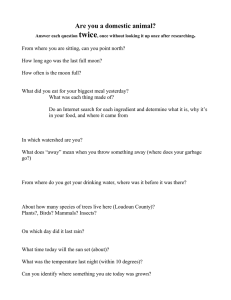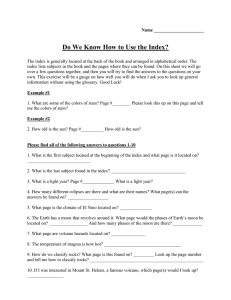
Earth, Moon,
Sun, and Stars
A Science A–Z Earth Series
Word Count: 153
Earth,
Moon,
Sun,
and Stars
Written by Alyse Sweeney
Visit www.sciencea-z.com
www.sciencea-z.com
Earth, Moon,
Sun, and Stars
Key elements Used in This Book
The Big Idea: Earth is part of a system of fast-moving objects in space.
Earth rotates on its axis, Earth revolves around the Sun, and the Moon
revolves around Earth. These movements affect important aspects of
our daily lives, including night and day, our calendars, the availability
of light and heat, and the appearance of the Moon and the Sun in
the sky. Humans have an ever-growing understanding of how the
Earth, Moon, and Sun move and interact. This understanding helps
us make sense of what we see in the sky, both by day and by night.
An understanding of our nearby space neighborhood can also inspire
future exploration deeper into space, which may someday even include
the discovery of life on distant planets.
Key words: air, dark, day, Earth, energy, light, Moon, night, planet, rock, sky,
spin, star, Sun, water, year
Key comprehension skill: Cause and effect
Other suitable comprehension skills: Compare and contrast; classify information;
main idea and details; identify facts; elements of a genre; interpret graphs,
charts, and diagrams
Key reading strategy: Visualize
Other suitable reading strategies: Ask and answer questions; summarize;
connect to prior knowledge
Photo Credits:
Front cover: © Paul Paladin/Dreamstime.com; back cover, pages 5, 7 (bottom),11 (Earth):
© iStockphoto.com/Andrey Prokhorov; title page: © iStockphoto.com/David de Groot;
page 3: © iStockphoto.com/Jon Mullen; page 4: © iStockphoto.com/Dimitar Marinov; page 6:
© Christos Georghiou/Dreamstime.com; page 7 (top): © iStockphoto.com/Eric Hood; pages 8 (Sun),
11 (Sun), 14 (Earth, Sun): © iStockphoto.com/George Argyropoulos; pages 8 (stars), 11 (stars),
14 (stars), 15 (Earth), 17 (Earth, stars): courtesy of NASA/GSFC; page 8 (car): © Jupiterimages
Corporation; page 9: © iStockphoto.com/Diego Cervo; page 10 (bottom): © iStockphoto.com/
Catherine Yeulet; page 11 (top): © iStockphoto.com/Licia Rubinstein; page 12: © iStockphoto.com/
Jill Chen; page 13: © Cathy Yeulet/123RF; pages 15 (Moon), 17 (Moon): © iStockphoto.com/
Dra Schwartz; page 16: © iStockphoto.com/Tom Hahn; page 17 (bottom): © iStockphoto.com/
Midhat Becar; page 18 (top): © iStockphoto.com/Manfred Konrad; page 18 (bottom):
© iStockphoto.com/Yu-qian Wang
Illustration Credit:
Page 10 (top): Cende Hill/© Learning A–Z
Written by Alyse Sweeney
www.sciencea-z.com
Earth, Moon, Sun, and Stars
© Learning A–Z
Written by Alyse Sweeney
All rights reserved.
www.sciencea-z.com
Look in the sky.
We see the Sun.
We see stars and the Moon.
3
4
Mercury
Jupiter
Venus
Earth
Mars
Saturn
Neptune
Uranus
We live on Earth.
Earth is a planet.
Earth is made of rock
and water.
Eight planets go around
the Sun.
5
6
It would take a car 177 years to get
from Earth to the Sun.
109 Earths would
fit across the Sun.
Earth has water and air.
The Sun is a star.
Living things need water
and air to live.
It is bigger than Earth.
7
8
Light turns
to heat.
Light comes
to Earth.
The Sun sends light to Earth.
9
The Sun’s energy warms
Earth’s air.
10
Earth
spins
like a top.
The spinning
makes day and night.
Night
One side of Earth faces
the Sun.
Day
It is day.
11
12
The other side of Earth
is dark.
Earth moves around the Sun.
It is night.
The trip takes one year.
13
14
The Moon does not
make light.
The Moon is smaller
than Earth.
The Moon looks bright when
the Sun’s light shines on it.
It is made of rock.
15
16
Earth
Moon
3rd
Quarter
New
Moon
1st
Quarter
Full
Moon
The Moon moves around
Earth.
One trip takes 28 days.
The sky is fun to watch!
17
18






